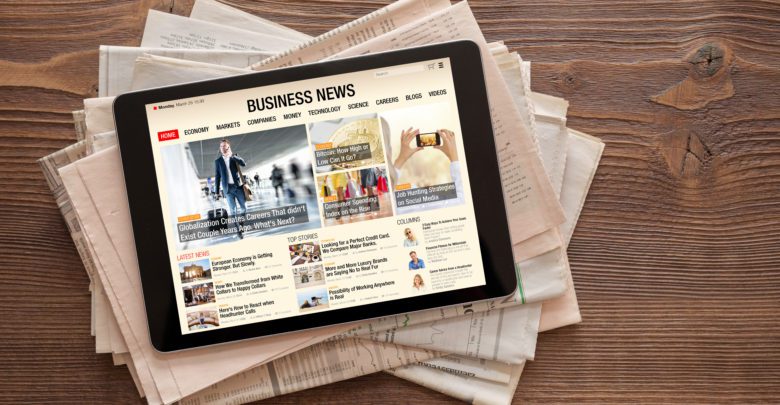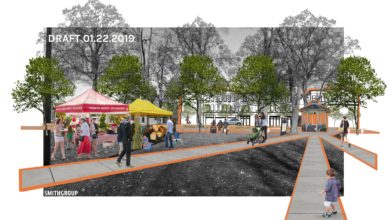Commentary: Filling the gap between print and what’s to come

By Dani Tietz
dani@mahometnews.com
When you’re 22 years old, the world is full of endless possibilities. Andrew, my husband, and I talked about those possibilities at length as we left our college home of Purdue. He, in the technology field, and I, in the arts field, had different opinions of what the future might or could hold.
We had a heated discussion on one of our trips from our hometown of Lafayette, Ind., to Mahomet to visit my in-laws; the topic was the future of paper.
He predicted in 15 years paper would be obsolete. And I, someone who loved opening a new hardcover book, who put pages on the walls to rummage through my thoughts, who enjoyed writing in cursive, said there was no way we would live in a future without paper.
Technically, neither of us were correct. You can still go to the store to buy paper and pens. You can still crack open a book and make marks in its margins. You can still write a letter to a friend, stick it in the mail and wait for a reply.
But, at the same time, you can send out an email on your phone, never having to open your laptop. There are devices that allow you to read an entire book. There are notebooks that allow you to write with a pen, and then transfer your work to the computer automatically — then you erase your work in the microwave.
Some of these new technologies have yet to catch on while some of our old ways of doing and thinking continue to morph into something more sustainable and efficient.
Last week, the announcement was made that the Mahomet Citizen, Mahomet’s weekly print publication, will no longer exist. This announcement is something that has been talked about and predicted for the last decade; yet, the pang of losing a print publication is no less.
I’m not sure if others enjoy going to the Mahomet Public Library to look at old prints of the Citizen, but I do a few times a year. I’ll ask for a span of years, with a particular topic in mind, then as I skim through the pages, I find pictures of friends, stories of community movement, lists of church services and stories of personal growth.
Some moms cut out the articles for their children, some businesses frame their business announcements, some schools make sure that their students see their picture. I always smile when someone tells their child, “You made the newspaper!”
Oftentimes, we look at news as a marketing tool; something to record our accomplishments and triumphs, something to tell the story of how we view ourselves in this present moment. But news in its finest form is literally a catalogue of present history.
Traditionally, we keep records of that present history in print. I loved visiting with the late Geraldine Hickle as I interviewed her. She had stacks and stacks of newspapers throughout her home; while she could tell me the stories of the days when Mahomet was just a tiny little town, she knew that there was something special about having a written history, too.
At one time print was something new, though. For centuries, among many cultures, oral tradition kept history and perspectives alive. Even stories within the Bible were recorded in print, although not the type of print we’ve enjoyed for many years, more than a century after they happened.
A few years ago, I drove across South Dakota to the Badlands. Along the route, there are two prominent billboards along the interstate: Wall Drug, 76,000-square feet of every tourist treasure that could ever be imagined and 1880 Town, a cultural center and village featuring 19th-century buildings and artifacts.
There were so many references to settlers and cowboys and the movement into the west that I wondered where the stories of the natives were stored. Or how they were stored. When I arrived at the south visitor center of the Badlands, I met a man who told me that his people, the Lakota tribe, had an oral history. Only one event was written down by the tribe’s chief each year; the winter count recorded the biggest event of the year.
The historical record of a drawing leaves historians to guess what was recorded. One year the Chief drew something that resembled “the year without sun.” Today, people believe that symbolized a solar eclipse.
The man I talked to, Matthew, only knew the oral stories passed down through his grandparents and parents. Many of the stories he could tell about his people involved white people coming onto their land and schools to teach them English.
I don’t pretend that my week in South Dakota makes me an expert on anything, but I do know that recording present history is both for us and for future generations. The drawings were turned into photographs, which in my lifetime have changed from polaroids to mailing in your film to one-hour prints to digital everything.
The photos that were taken and printed by documentary photographer and photojournalist Dorothea Lange are no more valuable than the photos taken by photojournalist Steve McCurry just because they were taken at different times, with different tools, published in different mediums.
The same principle can be applied to print. Over the decades the way that we print and the reasons that we print have changed. If you would have asked me 15 years ago if I would own and manage an online news organization, I would have said that was preposterous.
But, thinking that print is the end of news distribution or that an online platform will be the end all is what is preposterous.
At this time, we continue to move more and more towards digital products. My children, students at Mahomet-Seymour, rarely have paper products in their classroom. The text that they are required to read is usually provided through an online platform.
My family purchased a Kindle for me last Christmas because I wanted to get the Chicago Tribune, which you can no longer receive through print in our area. I have paper; I write my notes down with a pen, and I keep a list of projects on paper, but I write and edit on a computer.
Even today we are re-imagining what the computer looks like as it becomes pocket-size. In 15 more years my laptop may be obsolete. We continue to push forward in the platforms that we use, yet, we ask news to remain in its paper form.
In my mind, the great thing about news that is provided online is that anyone, anywhere can have access to it. The patterns and issues that we all engage with on a day-to-day basis are not unique to any one area, but can be found on local, regional and national levels. Today, we are seeing our issues on a worldwide level.
The problem of how we collect the present historical record is one that needs to be solved, though. As digital moves through all of its advances, digital material becomes obsolete. At this moment, there is not only a void in how we collect and retain digital data in the way that libraries currently collect newspapers, but there is also little discussion of the importance of collecting those materials for future generations.
It might be boring to think about these matters during this moment. But it could also be a hot ethical topic in who collects the record, who maintains the data and who or what is included in the collection.
It is time to move news organizations forward into the next realm. While we continue to build the platforms on which small town news lives, these are the issues and questions with which we grapple. I am constantly thinking about how we even move from the written word into the visual and oral world as the attention span of people is shortened.
At the very same moment, I think about how to offer a print product for these small communities. How can we provide access to news for all ages over all mediums in a way that is sustainable while maintaining the importance of the unbiased record of history?
The reality is that it will be news organizations who can reimagine everything from how we use print, to how we tell stories, to how we record history, to how we collect historical data that will be the ones to weather this storm.
It breaks my heart that yet another newspaper has fallen to what has now become an information crisis. In America, 65 million residents live in a county with only one source of news or none at all.
Still, we at the Mahomet Daily will continue on, to tell a community’s stories in the same way that newspapers have done for generations. Our commitment to providing a daily news source, focused on those stories that moms like to print and historians will come back to is unwavering. We will continue to use platforms that make access to information free and accessible to all while also looking into ways that we can reimagine print so that there is not a void as we move into this next phase of progress.
Most importantly, though, we will continue to have the conversations to make sure that the information we collect is available for generations to come.




I just paid for next year subscription…how will this get handled. I am disappointed with this news. C. Steeves